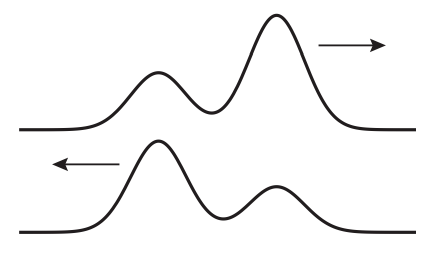24.7: Exercises
( \newcommand{\kernel}{\mathrm{null}\,}\)
selected template will load here
This action is not available.
( \newcommand{\kernel}{\mathrm{null}\,}\)
Exercise 24.7.1
When plucked, the D string on a guitar vibrates with a frequency of 147 Hz.
Exercise 24.7.2
Think of a flute as basically a cylindrical tube of length 0.6 m, open to the atmosphere at both ends. If the speed of sound in air is 340 m/s
Justify each of your answers briefly.
Exercise 24.7.3
The top picture shows a wave pulse on a string (string 1) traveling to the right, where the string is attached to another one (string 2, not shown). The bottom picture shows the reflected wave some time later.

If the tension on both strings is the same,
Explain each of your answers briefly.

